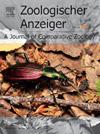加那利群岛(西北非洲,西班牙)Dilta Strand属的系统分类学(马基利亚科)——兼论微毛虫(昆虫科)的系统发育
IF 1.5
3区 生物学
Q2 ZOOLOGY
引用次数: 0
摘要
基于形态和遗传数据的系统发育推断往往由于进化趋同而表现出差异,使进化关系的准确确定复杂化。在微萎缩症中,缺乏全面的遗传研究留下了重大的空白,其中一些我们试图在这项工作中解决。我们对来自摩洛哥、伊比利亚半岛、加那利群岛和巴利阿里群岛的标本进行了线粒体和核标记的分子分析,代表了该目中的两个已知科和10个属。在研究过程中,我们对所研究分类群的命名进行了修订,并建立了3个新同义词(Machilis fastuosa Lucas, 1846 = Machilis bimaculata Lucas, 1846 n. syn = Machilis crassicornis Lucas, 1846 n. syn = Machilis italicus Grassi, 1887 n. syn.)和一个新组合Dilta fastuosa (Lucas, 1846) comb。11 .在加那利群岛,我们的采样导致发现了三个新的Dilta Strand属物种,1911,具有形态学和分子特征,将它们与其他同属物种(Dilta (Budilta) tilosina Palacios-Martínez &;García-París十一月;Dilta (Budilta) benahoarense Palacios-Martínez &;García-París十一月;和Dilta (Budilta) islabonita Palacios-Martínez &;García-París .十一月)。系统发育分析表明,Dilta的一个隐藏的快速进化辐射发生在加那利群岛。我们的研究结果表明,有必要对马基利亚科进行全面的分类审查,整合分子和形态数据,以解决现有的不一致,并提供更清晰的了解其进化史。本文章由计算机程序翻译,如有差异,请以英文原文为准。
Systematics of the genus Dilta Strand, 1911 (Machilidae) in the Canary Islands (NW Africa, Spain) with comments on the phylogeny of Microcoryphia (Insecta)
Phylogenetic inferences based on morphological and genetic data often exhibit discrepancies due to evolutionary convergences, complicating the accurate determination of evolutionary relationships. In Microcoryphia, the lack of comprehensive genetic studies has left significant gaps some of which we try to address in this work. We conducted molecular analyses using mitochondrial and nuclear markers on specimens from Morocco, the Iberian Peninsula, and the Canary and Balearic Islands, representing the two known families and 10 genera within the order. During our study, we revised the nomenclature of the studied taxa, and established three new synonymies (Machilis fastuosa Lucas, 1846 = Machilis bimaculata Lucas, 1846 n. syn. = Machilis crassicornis Lucas, 1846 n. syn. = Machilis italicus Grassi, 1887 n. syn.) and a new combination, Dilta fastuosa (Lucas, 1846) comb. nov. In the Canary Islands, our sampling led to the discovery of three new species of the genus Dilta Strand, 1911 with morphological and molecular distinctive traits that differentiate them from other congeneric species (Dilta (Budilta) tilosina Palacios-Martínez & García-París sp. nov.; Dilta (Budilta) benahoarense Palacios-Martínez & García-París sp. nov.; and Dilta (Budilta) islabonita Palacios-Martínez & García-París sp. nov.). The phylogenetic analyses herein suggest that a hidden rapid evolutionary radiation of Dilta took place in the Canary Islands archipelago. Ours findings show the necessity for a comprehensive taxonomic review of the family Machilidae, integrating molecular and morphological data to resolve existing inconsistencies and provide a clearer understanding of their evolutionary history.
求助全文
通过发布文献求助,成功后即可免费获取论文全文。
去求助
来源期刊

Zoologischer Anzeiger
生物-动物学
CiteScore
2.80
自引率
7.10%
发文量
75
审稿时长
>12 weeks
期刊介绍:
Zoologischer Anzeiger - A Journal of Comparative Zoology is devoted to comparative zoology with a special emphasis on morphology, systematics, biogeography, and evolutionary biology targeting all metazoans, both modern and extinct. We also consider taxonomic submissions addressing a broader systematic and/or evolutionary context. The overall aim of the journal is to contribute to our understanding of the organismic world from an evolutionary perspective.
The journal Zoologischer Anzeiger invites suggestions for special issues. Interested parties may contact one of the editors.
 求助内容:
求助内容: 应助结果提醒方式:
应助结果提醒方式:


